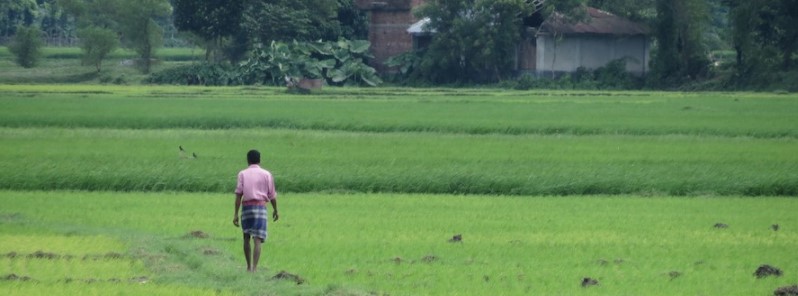Heavy rain, floods ravage Bangladesh rice planting area

Heavy rain and floods that hit Bangladesh this year have hurt prospects for rice area and production in the nation, forcing the country to brace itself for another season of highly probable less productive rice season. Bangladesh, once major rice produced, has become a major rice importer.
According to data provided by Global Agricultural Information Network (GAIN), the Foreign Agricultural Service of the U.S. Department of Agriculture (USDA), the total area planted to rice in Bangladesh is estimated at 11.372 million hectares in 2017-18, down from 11.748 million hectares in 2016 – 17. Meanwhile, production of rice is forecast at 33.150 million tonnes, down from 34.578 million tonnes in 2016-17.
"Massive amounts of crops lost to flooding imposed economic hardship on millions of farmers and households," the USDA noted.
"After a devastating early flash flood in March, a second monsoon caused heavy flooding in July and especially August. The flooding affected 34 districts out of 64 administrative districts of the country. Heavy late monsoon rains in the upstream provinces of Assam, Meghalaya, and Arunachal in India caused flooding in the north-eastern districts of Bangladesh. Out of 90 river water level monitoring stations in the country, 30 stations showed readings above the danger level of flooding. In one river, Jamuna at Bahadurabad point, the flood level reached 135 cm (53 inches) above the danger level, the highest flooding on record."
According to the country's Ministry of Disaster Management and Relief, the second spell of flood this year has severely affected 208 Upazilas and nearly 8 260 000 people. According to Flood Forecasting and Warning Centre, water levels of the Brahmaputra-Jamuna and Ganges-Padma rivers are in falling trend while Surma-Kushiyara is rising. Under the influence of current floods, 18 river points out of 90 measured stations in different rivers in all three basins – Ganges, Brahmaputra, and Meghna – have seen water flow above the danger level.
At the same time, water levels have been rising in 31 points in the rivers across the country. Of them, the Kushiyara River at Amalshid point has risen by 101 cm (40 inches), the Gur River at Singra point by 71 cm (28 inches) and the Atrai River at Baghabari point by 19 cm (7.5 inches). In addition, the level of the Lakhya River has swollen at Lakhpur point by 91 cm (36 inches), the Padma River at Goalanda point by 10 cm (4 inches), and the Surma River at Kanaighat point by 42 cm (16.5 inches).
Citing government of Bangladesh data, the USDA said flooding completely washed away an estimated 100 000 hectares and partially damaged another 500 000 hectares. The most affected areas were Aus rice, Aman rice, Aman rice seedbed, seedling, jute, and vegetables, the USDA said.
Among the paddy varieties, Boro accounts for the bulk of total production – ranging around 19.5 million tons – while Aman production comes second annually. It contributes 38 percent to the country's entire food production. The recent floods have highly affected Aman cultivation. According to a floods bulletin issued by the Department of Disaster Management of Bangladesh, a total of 591 647 hectares of Aman paddy field in 32 districts have been affected. Unofficial sources tend to set the total damage at a level far high. Rice prices around the country have already gone way high due to shortage of rice in the country.
According to forecasts by USDA, Aman production is likely to be around 350 000 tonnes less than that of last year. However, Agricultural Ministry of Bangladesh has not made any projections yet. While speaking to a national daily the country's Agriculture Minister Matia Chowdhury said, "Only six percent Aman has so far been harvested. I don't like to make a projection at this stage. A lot depends on the weather." She expressed optimism that the rice output would be moderately good as farmers tried hard to recoup flood losses during the very early stage of Aman transplantation. They are set to go on a full-swing harvesting of Aman. Meanwhile, the government has started distributing Aman paddy seedlings in different districts where floodwater is receding.
Bangladesh, which once was a major rice producer, has become a major rice importer, the USDA said. The country currently has several government-to-government rice import deals in place, including with Vietnam, Cambodia, Myanmar, India, and Thailand. In the case of India, it is the first rice trade deal between the countries in a decade.
Sources: USDA, World-Grain, The Daily Star, Dhaka Tribune
Featured image: Bangladesh Paddy Rice. Credit: Malcolm Manners

Commenting rules and guidelines
We value the thoughts and opinions of our readers and welcome healthy discussions on our website. In order to maintain a respectful and positive community, we ask that all commenters follow these rules:
We reserve the right to remove any comments that violate these rules. By commenting on our website, you agree to abide by these guidelines. Thank you for helping to create a positive and welcoming environment for all.